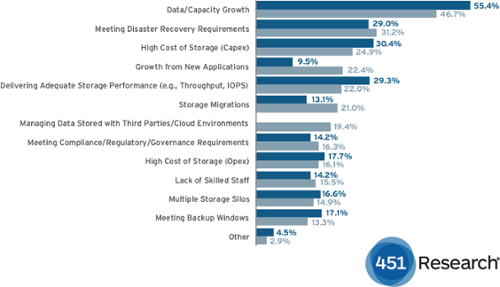Cloud computing is moving mainstream, and in the process is beginning to transform roles and priorities within the enterprise data storage infrastructure. Data from a recent 451 Alliance Storage study suggests storage professionals are no longer wholly preoccupied with adding storage capacity. Instead, attention is beginning to turn to other priorities, most notably ensuring that data and applications are adequately protected in the event of a failure, outage or more serious disaster.
Top Storage Pain Points
Q: What are your organization’s top three pain points from a storage perspective?

Organizations are adding new providers to the mix
Although data/capacity growth is still highlighted as the number one storage pain point, this was down almost 10 percentage points compared to a year ago. Data growth itself still continues unabated, but the impact of this growth is diminished as organizations utilize a variety of cloud services – in particular, public cloud – to shoulder the burden, especially for backup and archiving capabilities. Organizations are increasingly moving to hybrid cloud environments, bringing new providers into the mix (chiefly public cloud providers).
The message here for storage professionals is clear: The public cloud is a friend, not a foe. Public cloud is moving mainstream in many organizations; while it’s not going to completely replace on-premises IT for most, it is increasingly an important part of the mix in a hybrid IT environment. Senior IT leaders want to work with technical admins and other IT professionals who ‘get’ the role of public cloud – that means understanding both the advantages, and of course the limitations.
Be prepared for public cloud
Moreover, it’s critically important for organizations to know exactly what type of data could or should be moved into the cloud – is it highly sensitive, regulated, or data that is important to the business, for example? This places storage professionals in a strong position, because they inherently understand the importance of data protection, availability and resiliency.
One thing we have heard through our conversations with storage and IT professionals is that these teams are increasingly charged with taking on the storage and data aspect of an organization’s public cloud implementation, sometimes with very little advanced notice. Public cloud strategies are often ‘top down’ decisions, and when the public cloud gets the green light inside an organization, the pressure is on the internal IT team to implement it. Our advice here would be not to get caught out.
Here are the top ways storage and IT professionals can get themselves involved in the process:
- Educate yourself with your organization’s overall cloud strategy, spanning both public cloud and SaaS environments. Where are such services utilized today, and what benefits have they had to the organization overall?
- Familiarize yourself with the essential services offered by the major public cloud players.Which storage services could your organization take advantage of today and in the next planning cycle?
- Be open-minded. Even if your organization isn’t using cloud today, there may be aspects of cloud-based delivery that your organization could take advantage of; if not, then is there an opportunity to leverage some aspects of public cloud in the on-premises environment?
- Pick and choose. The cloud is not a binary ‘all or nothing’ decision, and is as much about the consumption experience as anything else; traditional ‘on-premises’ vendors are investing more time here, both in terms of product-level integration with public clouds, as well as more creative options around ‘pay as you go’ financing. Opex-centric IT isn’t for everyone, but it could be a very effective way of meeting short-term or temporary spikes of demand for IT capacity.
The latest research highlights the changing nature of the storage function as organizations looks to embrace transformation and shift to more agile, flexible IT models. The change that this opens up can be challenging for many IT professionals to adapt to, but the data is clear that this change is happening. Our message: Don’t fear the cloud; embrace it.
Do you have your finger on the pulse of tech trends? Join the 451 Alliance for exclusive research content on industry-wide IT advancements. Do I qualify?

